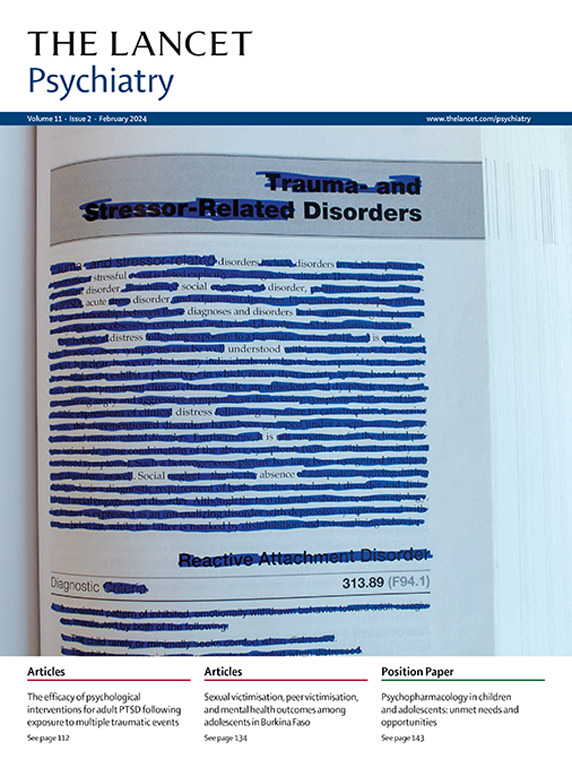Immersive virtual reality-assisted therapy targeting persistent auditory verbal hallucinations in patients diagnosed with schizophrenia spectrum disorders in Denmark: the Challenge assessor-masked, randomised clinical trial
IF 30.8
1区 医学
Q1 PSYCHIATRY
引用次数: 0
Abstract
Background
Auditory verbal hallucinations are among the most frequent and debilitating symptoms of schizophrenia spectrum disorders (henceforth termed schizophrenia), particularly in patients with treatment-resistant symptoms. Current treatment options have suboptimal response rates and innovative interventions are needed. This study aimed to evaluate the efficacy and safety of a novel immersive virtual reality-assisted therapy (Challenge-VRT) for auditory verbal hallucinations.Methods
In this randomised, assessor-masked, parallel-group superiority clinical trial, patients with schizophrenia were recruited from outpatient psychiatric services across three Danish regions. Key inclusion criteria were age 18 years or older, auditory verbal hallucinations for at least 3 months, and insufficient symptom response to antipsychotic medication. Exclusion criteria included being unable to identify a dominant voice, current substance dependence, and organic brain disorder. Participants were randomly assigned (1:1) via a secure web-based system using permuted blocks (block size 12), stratified by site and antipsychotic treatment. Allocation was concealed from outcome assessors. Participants were assigned to either Challenge-VRT (seven weekly immersive virtual reality sessions plus two booster sessions) or a control intervention of enhanced treatment-as-usual, matched in frequency and duration. Challenge-VRT was co-developed with individuals with lived experience of auditory verbal hallucinations. The primary outcome was clinician-rated auditory verbal hallucination severity measured by the Psychotic Symptoms Rating Scales-Auditory Hallucinations total score (PSYRATS-AH) at 12 weeks post baseline. Secondary outcomes were PSYRATS-AH frequency, PSYRATS-AH-Distress, The Voice Power Differential Scale, the Voices Acceptance and Action Scale, the Assertive Responding to Voices subscale from the Approve–Voices, and the Personal and Social Performance Scale, all at 12 weeks. Analyses followed the intention-to-treat principle and used linear mixed models. This study is registered with ClinicalTrials.gov, number NCT04661163, and is now completed.Findings
Between Nov 16, 2020, and June 14, 2023, 399 patients were referred for potential study inclusion, 62 patients were excluded (declined to participate or unable to be contacted), and 337 were assessed for eligibility. Of these, 66 did not meet the inclusion criteria. 271 participants were randomly assigned to Challenge-VRT (n=140) or enhanced treatment-as-usual (n=131). One participant was excluded post-randomisation, resulting in 270 included in the analysis of all outcomes. Participants had a mean age of 32·83 years (SD 11·9, range 18–72), 105 (39%) were male, and 165 (61%) were female. No data on ethnicity were collected. At 12 weeks, Challenge-VRT significantly reduced auditory verbal hallucination severity compared with enhanced treatment-as-usual on the PSYRATS-AH (adjusted mean difference –2·26 [95% CI –4·26 to –0·25]; p=0·027; Cohen's d, 0·27). Among secondary outcomes, a significant reduction in PSYRATS-AH frequency was observed in the Challenge-VRT group at both 12 weeks (adjusted mean difference –0·84 [95% CI –1·53 to –0·14]; p=0·018) and 24 weeks (adjusted mean difference –0·86 [95% CI –1·65 to –0·07]; p=0·034). No significant differences were found for other secondary outcomes. The intervention was generally well tolerated. Six serious adverse events occurred that might have been related to the Challenge-VRT intervention (five cases of hospital admission due to exacerbation of auditory verbal hallucinations and one episode of self-harm). No deaths occurred during the trial.Interpretation
Challenge-VRT showed short-term efficacy in reducing the severity of auditory verbal hallucinations in patients with schizophrenia, and the findings support further development and evaluation of immersive virtual reality-based therapies in this population.Funding
The Innovation Fund Denmark, Independent Research Fund Denmark, Innovation Fund North Denmark Region, Psychiatry Research Fund North Denmark Region, and The M L Jørgensen and Gunnar Hansen Fund.Translation
For the Danish translation of the abstract see Supplementary Materials section.沉浸式虚拟现实辅助治疗针对丹麦诊断为精神分裂症谱系障碍的患者的持续性听觉言语幻觉:挑战评估器屏蔽,随机临床试验
言语幻听是精神分裂症谱系障碍(今后称为精神分裂症)中最常见和最虚弱的症状之一,特别是在有治疗抵抗症状的患者中。目前的治疗方案反应率不理想,需要创新的干预措施。本研究旨在评估一种新型沉浸式虚拟现实辅助治疗(Challenge-VRT)对听觉言语幻觉的疗效和安全性。方法:在这项随机、评估器屏蔽、平行组优势临床试验中,从丹麦三个地区的门诊精神科招募了精神分裂症患者。主要入选标准为18岁或以上,至少3个月的幻听,对抗精神病药物的症状反应不足。排除标准包括无法识别主导声音、当前物质依赖和器质性脑障碍。参与者通过安全的网络系统随机分配(1:1),使用排列块(块大小为12),按地点和抗精神病治疗分层。分配对结果评估人员是隐藏的。参与者被分配到Challenge-VRT(每周七次沉浸式虚拟现实课程加上两次强化课程)或控制干预,即加强常规治疗,频率和持续时间相匹配。挑战- vrt是与有听觉言语幻觉经历的个体共同开发的。主要结局是在基线后12周用精神病症状评定量表-幻听总分(PSYRATS-AH)测量临床评定的幻听严重程度。次要结果是PSYRATS-AH频率、PSYRATS-AH-窘迫、声音权力差异量表、声音接受和行动量表、声音认可量表中的声音自信反应子量表,以及个人和社会表现量表,所有这些都是在12周时进行的。分析遵循意向治疗原则,使用线性混合模型。本研究已在ClinicalTrials.gov注册,编号NCT04661163,现已完成。在2020年11月16日至2023年6月14日期间,399例患者被推荐为潜在的研究纳入,62例患者被排除(拒绝参与或无法联系),337例患者被评估为合格。其中66例不符合纳入标准。271名参与者被随机分配到Challenge-VRT组(n=140)或常规强化治疗组(n=131)。1名参与者在随机化后被排除,导致270名参与者被纳入所有结果的分析。参与者平均年龄为32.83岁(SD 11.9,范围18-72),男性105人(39%),女性165人(61%)。没有收集有关种族的数据。在12周时,与常规治疗相比,挑战- vrt显著降低了听觉言语幻觉的严重程度(调整后的平均差值为- 2.26 [95% CI - 4.26至- 0.25];p = 0·027;Cohen's d, 0.27)。在次要结局中,挑战- vrt组在12周时均观察到psyrat - ah频率显著降低(调整后平均差值为- 0.84 [95% CI - 1.53至- 0.14];p= 0.018)和24周(调整后平均差- 0.86 [95% CI - 1.65 ~ - 0.07];p = 0·034)。其他次要结局无显著差异。干预一般耐受良好。发生了6例可能与Challenge-VRT干预有关的严重不良事件(5例因听觉言语幻觉加重而住院,1例自残)。试验期间无死亡病例。vrt在降低精神分裂症患者听觉言语幻觉严重程度方面显示出短期疗效,研究结果支持在这一人群中进一步开发和评估基于沉浸式虚拟现实的疗法。资助丹麦创新基金、丹麦独立研究基金、北丹麦地区创新基金、北丹麦地区精神病学研究基金和M L Jørgensen和Gunnar Hansen基金。翻译摘要的丹麦语翻译见补充资料部分。
本文章由计算机程序翻译,如有差异,请以英文原文为准。
求助全文
约1分钟内获得全文
求助全文
来源期刊

Lancet Psychiatry
PSYCHIATRY-
CiteScore
58.30
自引率
0.90%
发文量
0
期刊介绍:
The Lancet Psychiatry is a globally renowned and trusted resource for groundbreaking research in the field of psychiatry. We specialize in publishing original studies that contribute to transforming and shedding light on important aspects of psychiatric practice. Our comprehensive coverage extends to diverse topics including psychopharmacology, psychotherapy, and psychosocial approaches that address psychiatric disorders throughout the lifespan. We aim to channel innovative treatments and examine the biological research that forms the foundation of such advancements. Our journal also explores novel service delivery methods and promotes fresh perspectives on mental illness, emphasizing the significant contributions of social psychiatry.
 求助内容:
求助内容: 应助结果提醒方式:
应助结果提醒方式:


